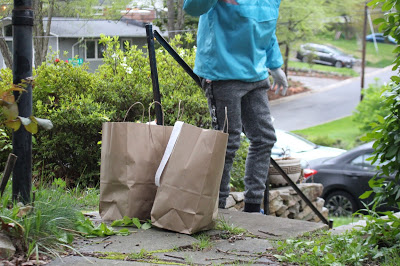Dinner at your doorstep
Our reliance on food delivery services will continue after quarantine
In only a matter of weeks, the COVID-19 pandemic has greatly damaged many of America’s central industries. The food industry, in particular, has been forced to climb a steep learning curve as it races to adapt to a reality in which hungry customers are not allowed to step through the front doors.
Fortunately, there is a solution for both businesses and consumers, even as most states have ordered stay-at-home orders: food delivery services such as Uber Eats, GrubHub, DoorDash, and Postmates.
Food delivery services are not the products of the quarantine induced by the pandemic. Pizza delivery and Chinese takeout have always been staples at American dinner tables. Moreover, popular platforms like Uber Eats, Postmates, and GrubHub were launched years ago.
It’s no surprise that these services have seen increases in demand for their services over the past several weeks. With the majority of America at home, the choice between cautiously trekking to the grocery store or downloading delivery services’ convenient ordering apps is an easy one.
Junior Althea De Castro, for one, began using food delivery services as a result of the pandemic. “Before the pandemic, I barely used any of the apps because of the delivery fee,” she says. “I thought that was unnecessary and I didn't want to pay that. But now that we're in the middle of a pandemic, I really don't have much of a choice.”
De Castro, the oldest of three children, has had to provide her family meals since her mother was recently diagnosed with COVID-19 and went into self-quarantine. Since her interview, De Castro’s mother has now recovered.
Services like Uber Eats and Postmates have been incredibly helpful for De Castro, as cooking isn’t exactly her area of expertise. “I'm not gonna lie, it's pretty hard because I can't really cook,” De Castro says. “But using these delivery services has really put me at ease in providing food for my siblings and I.”
Even so, constantly ordering out still has its challenges. “I guess really the only downfall for me, ordering out, is that [such services] can get quite expensive,” she says.
De Castro still has to adjust to her newfangled experience with ordering from meal delivery services, which collectively saw a 24 percent year-over-year growth through the end of March. She and many others in a similar predicament will continue to rely on this different approach to dining. “It's not like we're struggling with getting food, it's just a lot different from before,” she says.
However, others like junior Ana Eve Rubin have qualms about using such services amid a highly contagious virus. “I have never used one of those companies before because it just freaks me out to think about other people handling my food,” Rubin says. “It definitely makes me nervous because you don't know who has the virus,” she says.
While helpful to some, students like Rubin are still skeptical and reluctant to use such services. But these worries have been partially discredited. “No reported cases have been linked to the contamination of food. The main risk of transmission is from close contact with infected people,” reported the Food and Drug Administration. Most of these services are still in development and many people are confused on certain areas, such as how restaurant owners and drivers are paid through them.
For starters, services like Uber Eats hire drivers 19 and older, who can decide their own working hours and schedule. Other requirements include being able to lift 30 pounds and using a vehicle manufactured after 1999. Uber Eats drivers are paid $8 to $12 an hour and receive 100 percent of their tips.
There is contention around how fairly restaurants are paid when they partner with food delivery services. Uber Eats requires partnered restaurants to pay 30 percent of their listed prices to the company for delivery fees. However, Uber does not allow restaurants to increase their prices to cover the delivery cost.
Some restaurateurs feel short-changed by such restrictions and would rather have customers order directly. In an Instagram post, Maryland restaurant owner Ashish Alfred asked people to renounce food delivery services because of the “25-30% commission rates” that they have to pay. “Delete every delivery app on your phone,” he declared.
Alfred is not alone in his frustrations. Uber Eats, along with DoorDash, Postmates, and GrubHub, have received further backlash from consumers and were sued in a class-action lawsuit in Manhattan federal court for charging “exorbitant” delivery fees.
Business practices aside, food delivery services evidently will play a vital role in the restaurant industry as the world continues to become increasingly reliant on the internet. With the ubiquity of online shopping and food delivery, the internet will prove to be necessary for the services it provides our society. For local restaurants whose customers no longer have the option to dine-in, these meal-delivery services could be a saving grace.
Of course, there is much room for improvement for these services to benefit local restaurants more and charge lower rates, but nevertheless, delivery services provide an important platform for customers to show support for their favorite local eateries and explore new ones at the same time. “It's always nice to discover different cuisines and order from places other people have recommended to me,” De Castro says. “It feels good knowing that these small businesses are being supported,” she says.
Show comments
Comments
No comments.
Please ensure that all comments are mature and responsible; they will go through moderation.
